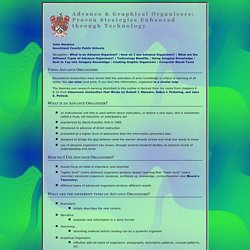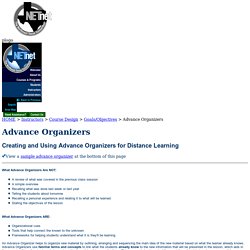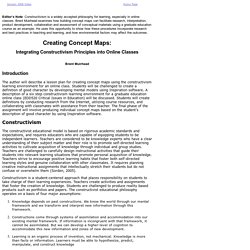

Learning Concept Map. Advance Organizer. Advance Organizers. Introduction to ideas of Advance Organizers in Teaching and Learning Advance organizers can be thought of as extremely well-designed and thought out unit outlines.

Presented before the actual topics to be learned (in advance of learned material), it is notable that the Advance Organizer model is designed to prepare students for how to think about the lessons to come, giving some detail about terminology and connections but not giving the entire unit content. Advance organizers are not designed for day-to-day use; instead, they are used to provide a structure at the beginning of a major unit of study. Ausubel suggests 2 different types of organizers for 2 different purposesTthough others have suggested other organizers, they seem to fall within these categories: 1. 2. It is important to note that Ausubel’s Advance Organizers provide a structure for student thinking, not just a structure for lessons themselves. Basic Literature Review Kraiger, Kurt and Cannon-Bowers, Janis A.
Lesson Outline. Advance Organizers. Advance and Graphical Organizers. John Hendron <p> JavaScript must be enabled to display this email address.

</p> Goochland County Public Schools Navigation: What is an Advance Organizer? | How do I use Advance Organizers? NETnet Creating Advance Organizers. Creating and Using Advance Organizers for Distance Learning View a sample advance organizer at the bottom of this page What Advance Organizers Are NOT: A review of what was covered in the previous class session A simple overview Recalling what was done last week or last year Telling the students about tomorrow Recalling a personal experience and relating it to what will be learned Stating the objectives of the lesson What Advance Organizers ARE: Organizational cues Tools that help connect the known to the unknown Frameworks for helping students understand what it is they'll be learning An Advance Organizer helps to organize new material by outlining, arranging and sequencing the main idea of the new material based on what the learner already knows.

Advance organizers place the most general and comprehensive ideas at the beginning of a lesson and progress to more structured and detailed information. Keep the ARCS Method in mind as you create your own Advance Organizers. Examples: Back to top. Cmap Software. Joseph D. Novak & Alberto J. Cañas Institute for Human and Machine Cognition Pensacola Fl, 32502 www.ihmc.us Technical Report IHMC CmapTools 2006-01 Rev 2008-01 Introduction Concept maps are graphical tools for organizing and representing knowledge. Figure 1. (click on the image to display a larger image) Another characteristic of concept maps is that the concepts are represented in a hierarchical fashion with the most inclusive, most general concepts at the top of the map and the more specific, less general concepts arranged hierarchically below.
Another important characteristic of concept maps is the inclusion of cross-links. A final feature that may be added to concept maps is specific examples of events or objects that help to clarify the meaning of a given concept. Concept maps were developed in 1972 in the course of Novak’s research program at Cornell where he sought to follow and understand changes in children’s knowledge of science (Novak & Musonda, 1991). Figure 2. Figure 3. Jan06_article02. Editor’s Note: Constructivism is a widely accepted philosophy for learning, especially in online classes.

Brent Muirhead examines how building concept maps can facilitate research, interpretation, product development, collaboration and assessment of conceptual materials using a graduate education course as an example. He uses this opportunity to show how these procedures incorporate research and best practices in teaching and learning, and how environmental factors may affect the outcomes. Brent Muirhead Introduction The author will describe a lesson plan for creating concept maps using the constructivism learning environment for an online class. Constructivism The constructivist educational model is based on rigorous academic standards and expectations, and requires educators who are capable of equipping students to be independent learners.
Constructivism is a student-centered approach that places responsibility on students to take charge of their learning experiences. 1. 2. 3. 4. 5. 6.